MSI GT627: Bringing Balance to the Force?
by Jarred Walton on April 29, 2009 4:00 AM EST- Posted in
- Laptops
Balanced Gaming Performance
We've chosen to focus on "reasonable" settings for the games below. That means we run Assassin's Creed and Company of Heroes in DX9 mode at maximum detail setting - DX10 reduces performance by quite a bit in AC and by a much larger amount in CoH. We run Crysis at Medium settings (for reference, High detail drops performance almost in half: 18.75 FPS for the GT627 at 1680x1050). The remaining games are at maximum detail settings, but without any anti-aliasing. It's also important to remember that driver updates have improved performance in quite a few games, so results from the Alienware m15x, Gateway P-171XL, P-6831, and P-7811 would improve in many games if we used the latest driver.
Again, we chose to focus on 1680x1050 as a baseline performance comparison. We use an external LCD to run at that resolution when necessary, as in the case with the GT627. If you don't care about comparative performance, focus on the performance at the native resolution of 1280x800, shown in red. Overclocking results at 1280x800 are shown in orange, 1680x1050 will be green, and 1080p is in gold.

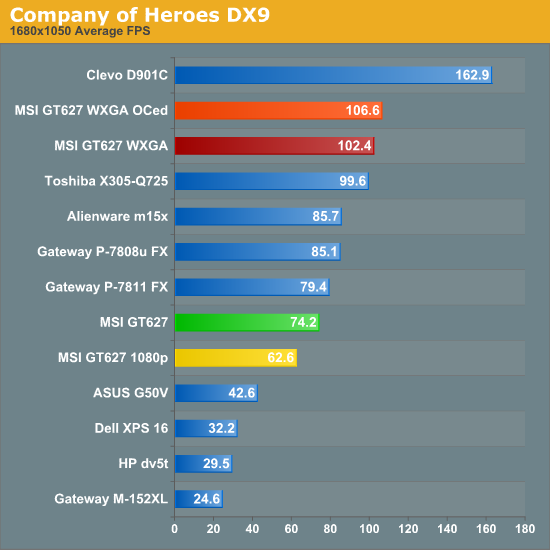
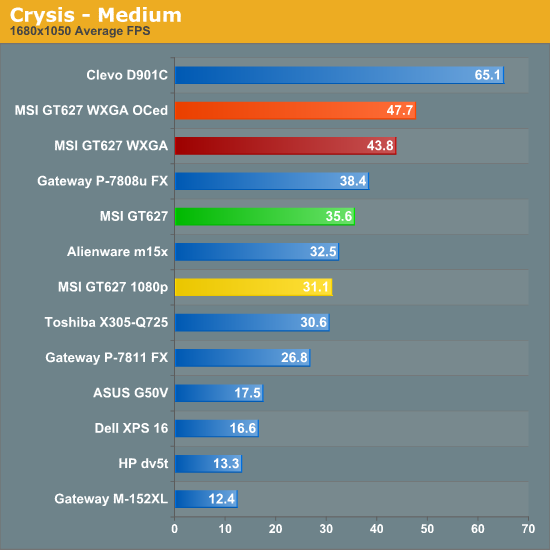
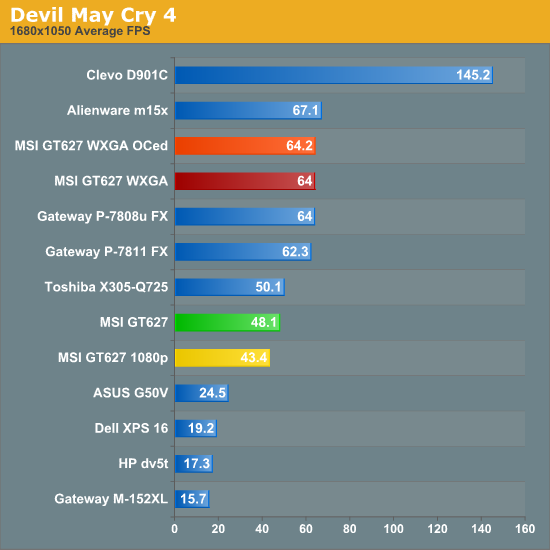
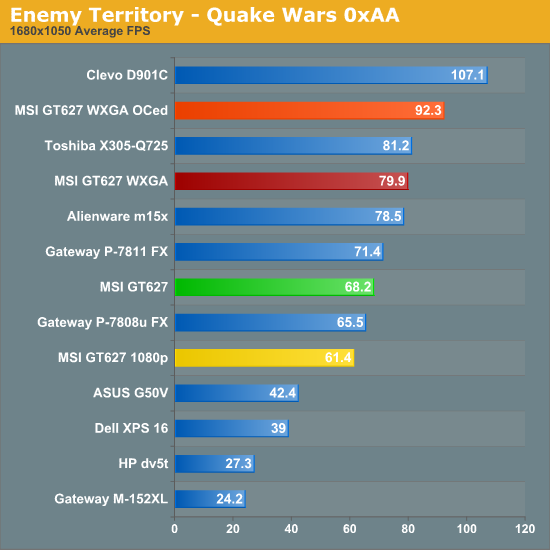

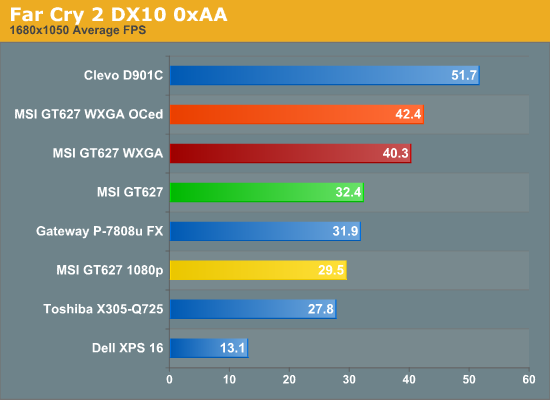
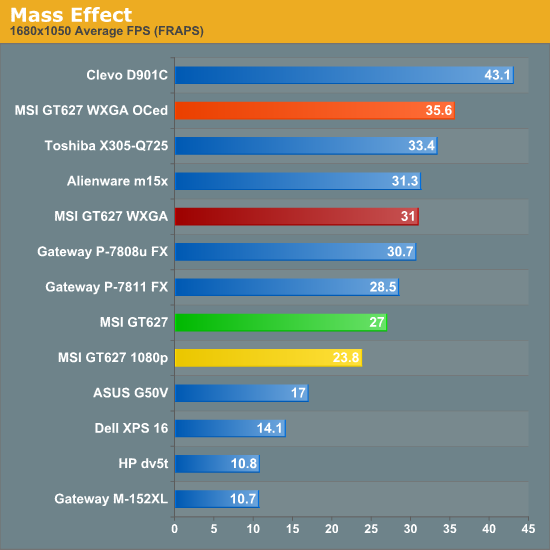
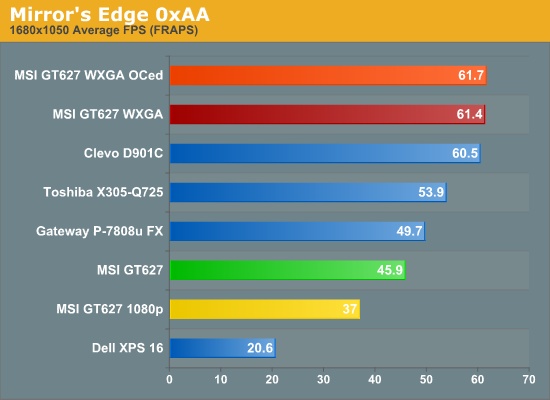
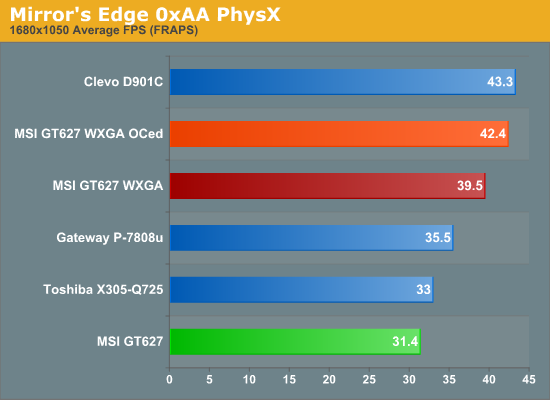
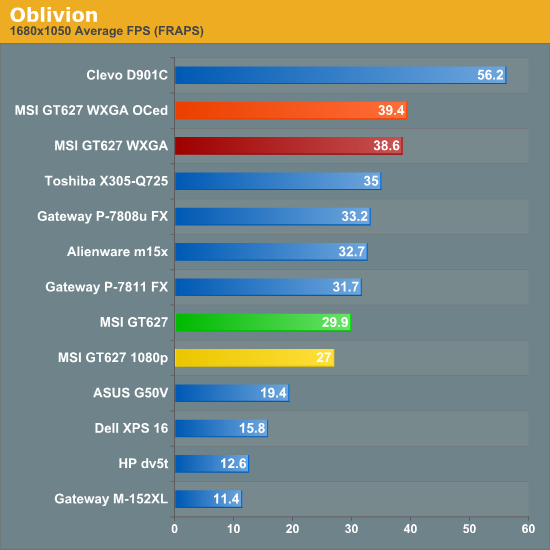
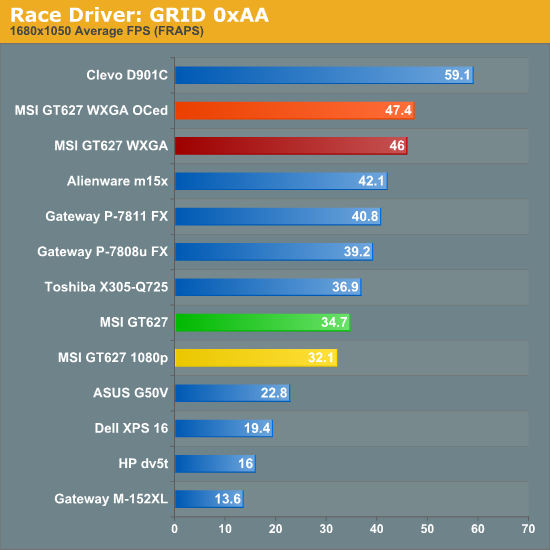

Here is where the "balanced" approach to gaming notebooks clearly pays off. Despite having a "slower" dual-core processor and a slightly slower 9800M GS graphics chip, the MSI GT627 is very competitive with the Gateway P-7808u. It's on average 10% slower in the tested games, and in a few cases it's actually faster because of the higher CPU clock speed. There are a few games where the quad-core CPU in the P-7808u definitely helps, i.e. Devil May Cry 4, but those tend to be the exception rather than the rule. If we look at just the GPU difference, the Gateway's 9800M GTS has core and shader clock speeds that are 13% higher than the MSI's 9800M GS, while memory bandwidth remains the same. Many games are going to be limited by GPU core/shader performance, so the 10% average improvement is exactly what we would expect if the CPU isn't a bottleneck.
While the GT627 may not be the fastest gaming notebook in terms of raw power, we again need to consider performance at the native resolution. 1280x800 performance doesn't tax the GPU nearly as much of 1680x1050, so the combination of the GeForce 9800M GS, Core 2 Duo P8400, and WXGA LCD works out very well. In fact, looking at the overclocked results, we can see that many games are CPU limited at the native resolution, which makes the overclocking feature a nice extra. The only game we test where performance isn't acceptable at 1280x800 is Crysis at high quality defaults, but even that still looks and runs fine at medium detail.
We would be remiss, however, if we didn't point out the fact that even the best gaming notebooks are still a generation (or more) behind current desktop offerings. The 9800M GS used in the MSI is essentially the same as the 9600 GT desktop card. In fact, it's a bit slower, since core/shader/GPU speeds on the desktop part are still higher. Put another way, if you don't need mobility you can build a complete budget system, add a reasonable video card like the Radeon HD 4770 - or even the GeForce GTX 275 - and still end up with a price several hundred dollars cheaper than this midrange gaming notebook. The only reason to purchase a gaming notebook is if you need/want mobility... or if you just have a lot of money to spend. Otherwise, the gaming experience will be far better on even a basic desktop system.










47 Comments
View All Comments
fwacct4 - Saturday, May 2, 2009 - link
I'm glad noise has been evaluated in this laptop review as well. Lots of stuff on desktop noise, but since I can't stick a laptop in a closet and still run it, fan noise on a laptop distracts me like nothing else. Even worse are laptop fan noise coming from people sitting near me.Rolling Camel - Friday, May 1, 2009 - link
I'm really looking forward to a GT725, it is the uber notebook below $2000, not Gateway. My A64 3000+ is really slow and i need a computer with enough graphics power. So either i get an Phenom 2 X3 and Hd4870 based system, or get the GT725. The desktop is cheaper and more powerful, but i need mobility for my school.I know the GT725 has some worries:
1.The keyboard, although there is a solution for it.
2.Many report that the track pad wears fast, as if i will ever use.
3.I'm worried about the thermal dissipation. The R770 seems more fit for the task.
4.Warranty and customer service.
The HD4670 equipped EX 625 is very tempting with it's $750 price tag.
ira176 - Friday, May 1, 2009 - link
Apple's batteries are custom made lithium polymer. They are not typical run of the mill lithium ion cells that most manufacturers use. Apple's batteries use all of the space in their design and have no "dead" space due to round cells packed in a rectangular battery as most win pc notebooks have. Although Apple's OS may be a little more conservative on battery usage it's got to be the mere fact that there's more capacity in their battery design, and maybe even cherry picked hardware and LED lcd displays. Win pc's could probably see better battery life with better battery designs and better part choices. Of course we would pay more for that pc notebook.JarredWalton - Friday, May 1, 2009 - link
Apples batteries are rated at between 40 Whr and 50 Whr in the current models - 40 for the Air, 45 for the standard MacBook, and 50 for the Pro if I'm not mistaken. The construction and material used in a battery does not affect the rating in Whr. If something is designed to output 5200 mA at 9.6V, it is a 50 Whr battery. A lithium polymer might be lighter for the total capacity, but I'm not talking about capacity.Given the above, it means that Apple's standard MacBook apparently consumes around 9.4W when surfing the Internet. In contrast, the ASUS U6V eats up 21W on average for the same task. I'm hoping to get a MacBook for a bit just to make sure there's nothing else going on, but Apple apparently uses less power surfing than most Vista PCs use at idle.
Zan Lynx - Friday, May 1, 2009 - link
From what I've gathered about it, Apple "cheats." They can turn hardware on and off and do clock scaling that isn't available via ACPI.JarredWalton - Friday, May 1, 2009 - link
Lenovo indicated to me at CES that they actually turn off components that aren't in use, which is how they improve battery life (supposedly - still waiting for a test sample). It makes sense that if your optical drive is inactive, completely shutting off power makes more sense than a .5W sleep state. They said they also power off the speakers when the sound is muted or when headphones are connected (another few hundred mW). I don't know about other devices, but really I don't care if it's "cheating" - custom designed hardware that functions better than the competition is fine as long as it works properly. Windows 7 is supposed to enable some better power savings (up to 11% better battery life I've heard), so we'll see.The0ne - Thursday, April 30, 2009 - link
If you're going to game on it why not just get one with 17" LCD? Better yet, get one with 1900x1200 and everything is just beautiful :)It's great that the article addresses the LCD issues. I mean come on, it's one of the main components when considering a laptop.
Rob94hawk - Thursday, April 30, 2009 - link
Where is this Clevo901c laptop?JarredWalton - Thursday, April 30, 2009 - link
I'm not sure what you mean. Do you mean where are the specs? If that's your question, the Sager NP9262 is a Clevo D901C chassis. Several other companies (WidowPC, AVADirect, Eurocom, etc.) use the Clevo chassis and rebrand it as their own, so I figured listing the original manufacturer in that case made the most sense.GoatMonkey - Wednesday, April 29, 2009 - link
The display on the MSI GT627 218US is apparently different, because it is listing max resolution of 1680x1050. I'd like to know if that display has better contrast ratio.Also, any news on the upcoming MSI GT628 with the nVidia M160?